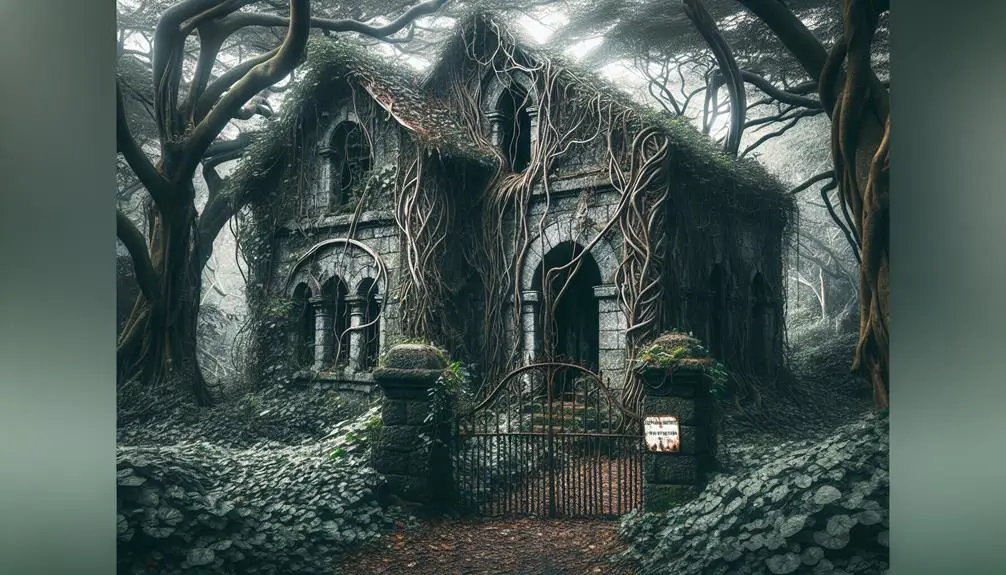Explore the lasting importance of colonial ghost town remnants. These silent structures symbolize past civilizations and their challenges. Abandonment due to conflicts or disasters shaped these towns. The economic fallout disrupted trade and local businesses. Preservation efforts maintain their historical and architectural value. Diverse influences like Spanish courtyards and adobe constructions define their uniqueness. Tourism opportunities exist, blending restoration with historical integrity. Discover deeper insights into the rich history embedded in these ghostly reminders of a bygone era.
Key Points
- Colonial ghost town remnants preserve tangible history.
- They reflect past settlement patterns and struggles.
- Abandonment impacts trade routes and local economies.
- Preservation efforts enrich historical narratives and community pride.
- Diverse architectural styles showcase historical context and influences.
Colonial Ghost Town Origins
How did colonial ghost towns come into existence?
Colonial ghost towns originated from the ebb and flow of colonial settlement patterns throughout history. These towns hold immense historical significance as they serve as tangible remnants of past civilizations, offering a glimpse into the lives of early settlers and the challenges they faced.
During the colonial period, settlers established towns for various purposes such as trade, defense, or religious freedom. However, factors like conflicts, natural disasters, diseases, or economic downturns could lead to the abandonment of these settlements, resulting in the formation of ghost towns. The deserted structures and empty streets of these towns stand as silent witnesses to the struggles and triumphs of the past.
Exploring colonial ghost towns allows us to connect with our heritage and understand the complexities of early colonial life. By studying these remnants, we can appreciate the resilience of our ancestors and learn valuable lessons about community, perseverance, and the cyclical nature of history.
Economic Impact of Abandonment
The abandonment of colonial ghost towns had significant economic repercussions that reverberated through the region's trade networks and local economies. As these once-thriving settlements fell into disrepair, the economic impact of abandonment became increasingly pronounced.
- Decline in Trade: With the abandonment of these towns, trade routes that once connected different regions were disrupted. The abandoned infrastructure, such as crumbling roads and dilapidated marketplaces, hindered the flow of goods and services, leading to a decline in trade activities.
- Loss of Revenue: The urban decay that characterized these ghost towns resulted in a loss of revenue for local businesses and artisans. As buildings deteriorated and populations dwindled, businesses faced a sharp decline in customers and struggled to sustain themselves.
- Unemployment: The abandonment of these towns also led to a rise in unemployment rates. Many residents who relied on the local economy for employment found themselves without jobs as businesses closed down due to the economic downturn caused by urban decay.
Cultural Heritage Preservation Efforts
Efforts to preserve the cultural heritage of colonial ghost towns have been instrumental in safeguarding the historical significance and architectural legacy of these abandoned settlements. Community engagement plays an important role in these preservation endeavors, as it fosters a sense of ownership and pride among local residents and stakeholders. By involving the community in the preservation process, historical narratives aren't only preserved but also enriched, allowing for a more thorough understanding of the past.
Preservation efforts often focus on documenting and interpreting the history of colonial ghost towns, ensuring that their stories aren't lost to time. Through the maintenance of historical sites and structures, these initiatives help to keep the cultural heritage alive for future generations to appreciate and learn from. By incorporating historical narratives into educational programs and guided tours, preservationists can further promote awareness and appreciation for these unique remnants of the past. Overall, cultural heritage preservation efforts serve as an essential link to our shared history, connecting us to the people and events that shaped the colonial era.
Architectural Influences and Styles
In studying colonial ghost town remnants, one can observe a diverse array of architectural influences and styles that reflect the historical context of the era. The blend of Spanish influence and locally sourced materials created unique structures that stand as evidence to the past. Here are three key features you may encounter:
- Courtyards: Many colonial ghost town remnants feature central courtyards influenced by Spanish architecture. These open spaces were often surrounded by arched walkways and served as gathering places for the community.
- Adobe Construction: The extensive use of adobe, a mixture of mud and other materials, showcases the reliance on local resources for building purposes. The earthy tones of adobe walls harmonize with the surrounding landscape, emphasizing a connection to the environment.
- Terracotta Roof Tiles: The use of terracotta roof tiles not only adds a distinctive aesthetic appeal but also highlights the practicality of utilizing locally available materials. These tiles are durable and provide insulation, reflecting the resourcefulness of colonial builders.
Tourism Potential and Challenges
Amidst the colonial ghost town remnants lies a complex interplay of tourism potential and challenges waiting to be explored. The ghostly attractions of these abandoned sites offer a unique opportunity for visitors to immerse themselves in a bygone era, providing eerie yet enthralling visitor experiences. However, unleashing the full tourism potential of these locations requires careful consideration of restoration projects and community engagement.
To enhance visitor experiences, restoration projects play a vital role in preserving the historical integrity of colonial ghost towns. By restoring key structures and implementing interpretive signage, these sites can offer a more immersive journey into the past. Yet, such projects often face challenges due to limited funding and the delicate balance between preservation and modernization.
Moreover, community engagement is essential for the sustainable development of tourism in these areas. Involving local residents in decision-making processes and tourism initiatives not only fosters a sense of ownership but also guarantees that the benefits of tourism are shared equitably. Balancing the preservation of ghost town remnants with the creation of engaging visitor experiences requires a nuanced approach that considers both historical significance and contemporary tourism trends.
Frequently Asked Questions
What Role Did Indigenous Populations Play in the Creation and Eventual Abandonment of Colonial Ghost Towns?
You must explore the Indigenous influence on colonial ghost towns' creation and abandonment. Various theories surround these deserted settlements, shedding light on the complex interactions between settlers and native populations shaping the historical landscape.
How Were Gender Dynamics and Social Hierarchies Reflected in the Layout and Design of Colonial Ghost Town Buildings?
When exploring colonial ghost town buildings, you'll notice how gender roles, social hierarchy, and design aesthetics interplay. Architecture often mirrors prevailing social norms, reflecting power structures and divisions within the community's layout and design.
Are There Any Myths or Legends Surrounding Specific Colonial Ghost Town Remnants?
Step into the shadows of colonial ghost town remnants, where whispers of paranormal encounters and echoes of folklore linger. Explore the mysteries surrounding these sites, where archaeological findings entwine with preservation efforts to preserve their enigmatic tales.
How Have Climate Change and Natural Disasters Affected the Preservation of Colonial Ghost Town Structures?
Climate change and natural disasters have greatly impacted the preservation of colonial ghost town structures. Environmental changes challenge preservation strategies, jeopardizing archaeological findings and the cultural significance of these remnants. Adaptation and vital measures are essential.
What Are the Ethical Considerations Surrounding the Excavation and Study of Colonial Ghost Town Sites?
When excavating colonial ghost town sites, ethical considerations are crucial. Public engagement fosters understanding, while cultural sensitivity respects the past. Archaeological ethics guide preservation practices, ensuring these remnants are studied respectfully and responsibly for the benefit of future generations.



